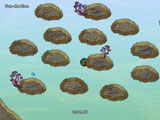Swinging Retro Alien Computer Game
Dillon Cower’s String Theory was created for the second Experimental Gameplay Project competition. It’s a computer game intended to be played with a DDR-style dance pad, although it has keyboard controls as well. It’s fairly short, but has an excellent, innovative implementation of a swinging-style play mechanic that’s fun to play around with.
Swinging About
The controls in String Theory are pretty simple. Your little alien dude has four tentacles, and you can fire them in any of the 8 cardinal/ordinal directions. The tentacles latch on to the environment, but lose their grip after a few seconds. At first I wasn’t firing more than one string in any given direction. This is a mistake–when the game speeds up you really need to fire multiple times in the same direction to move around quickly.
I don’t have a DDR pad lying around at the moment, so unfortunately I wasn’t able to try the game as it was intended. I imagine it would be rather frantic!
Camera Path
The camera in String Theory follows a pre-defined path at a pre-defined speed. You lose if your character moves outside of the screen. Although this makes the game a little hard to learn, at first, it also provides an excellent structure to what would otherwise be a simple physics test. It’s a really simple–if punishing–way to structure the game.
I would love to see this physics mechanic set free of the camera limitations, though. It would be interesting to navigate the character around a free-moving world with some enemies, moving platforms, and other elements to spice things up. There’s definitely some potential here for a larger computer game with more features.
Dulfyns R Savvd
The single level in String Theory isn’t very long (I think 110 seconds or so unless you modify the camera speed settings). Still, it’ll take you a few tries to make it all the way to the end. You’ll spend more time playing than downloading, which is always a good ratio. The game forces you to restart from the beginning when you lose, which can get a little tedious, but it also gives you a chance to experiment a bit and hone your skills.


(String Theory Computer Game Screenshots)
Freeware Rules
String Theory has been released as freeware. It’s a great game on its own right, and its short play time–under a minute–makes it the perfect distraction from work. Just click on your shortcut, play for 30 seconds, and then get back to doing whatever it was you were supposed to be doing. It’ll be our little secret.
Download String Theory Computer Game (3.31 MB) [mirror]
Make sure you head on over to the Experimental Gameplay Project for more information on the competition and to check out the other entries.
Related Posts:
- Double Dose of Fun with Double Wires
- List of Physics Games
- Insane Stunt Car Antics: Trackmania Nations
Gish + Pinball + Amazing Art = Gumboy!
It’ll be hard to escape a Gish comparison when first talking about CINEMAX’s Gumboy Crazy Adventures. The main character is a blob of springs; you roll around, stick to things, and generally interact with your physics environment. At first glance the two games seem quit similar. When you actually play Gumboy Crazy Adventures, though, the similarities quickly dim and you realize you’re playing something completely unique. Something occasionally and horrendously frustrating–but definitely different!
Stunning Visuals
I know this is a website about physics games–and I’ll talk about how well (or not) the controls handle in a second–but Gumboy Crazy Adventures deserves special mention of its standout sound and visuals. In fact, I’d be surprised if the game wasn’t a finalist in at least one of those categories in this year’s IGF. The game simply looks amazing, particularly at native resolution on a nice LCD display. Wow. The ridiculous production polish is actually one reason I’m still playing the game in spite of its physics.
Gumboy Controls
The movement mechanic in Gumboy Crazy Adventures is touchy. Unlike other blob rigs, like Gish, the gumboy has very little give. He ricochets off anything, even slight angles. Rotation instantly snags, catapulting the character forward. There isn’t any of the typical fluidly and absorption of spring-based systems. It’s much more like pinball than a liquid blob.
You actually control the character’s rotation. The game does apply a very slight arbitrary left/right impulse, too, but not enough to provide any real locomotion. I find myself wishing the ball was sloppier and easier to manage when I bounce around for 10 seconds trying to get into a narrow passage. It can be insanely frustrating at times. When I move along a line that flows well, though, I can definitely appreciate the play mechanic as something entirely unique that stands on its own. I just wish that feeling occurred much more frequently than the brutal frustration the later levels happily dish out.
Fetch, Gumboy!
The actual play experience in Gumboy Crazy Adventures is essentially fetching and guiding other objects. In each level you quickly acquire a magnetic repulsion force, which you must use to push various items to these crazy-ass creatures. In one series of levels, you’re required to collect drops of water (which, of course, break open if they fall too far or touch any dreadfully annoying caterpillars).
Because of this play mechanic, the levels have a lot of back-and-forth action. You’re constantly backtracking and maneuvering on routes that cross each other. CINEMAX has done a great job designing the levels with this mind. There are numerous paths designed into each level, yet the stages retain a decent sense of exploration.


(Gumboy Crazy Adventures Game Screenshots)
Variety and Replayability
Gumboy Crazy Adventures has over 40 levels, broken into groups of 5-6 per environment. The stages themselves have a decent amount of variety, and the core gameplay is extended by powerups: jump, sticky, air ball, star ball, and so on. They’ve managed a good job of embellishing the core movement mechanic.
Conclusion
Overall, though, I find myself dissatisfied with the physics in Gumboy. If the game was as fun to play as it was to look at and hear, it would be an instant runaway hit. I still think they have a fantastic game on their hands, and it should do well for them. It isn’t a game that I’ll be replaying as much as others in my physics game library, that’s all. The litmus test I usually apply for physics titles is whether it would still be enjoyable with solid-color placeholder graphics. I’m afraid that Gumboy Crazy Adventures just wouldn’t pass…
Still, the game is a great title overall and definitely worth the $20. Check out the demo!
Download Gumboy Crazy Adventures Demo (42 MB)
The full version of the game is $19.95 and available to purchase at the official website.
Related Posts:
- List of Physics Games
- Insane Stunt Car Antics: Trackmania Nations
- About
- The Squishiest Damn Starfish Around
- One-Button Fun With Strange Attractors
Toribash 2.0 Released
Hampa sends word that his beautiful baby, Toribash, has reached the 2.0 milestone. Toribash 2.0 has gone the Soldat business model route, and is available as both a free demo and registered version (which is currently $19.95 until the end of October). But first, enjoy some tempting video of the official Sumo mod–Hampa really is as good as you would expect him to be:
The registered version includes these benefits above and beyond the demo version:
- Full multi player access, including registered only servers with ‘buddies’ system, protected nicks and head skins
- Join the competition in the online ranking system
- Custom mods, such as the official sumo mod
- Alter the rules of Single player and hosted Multi player games
- Host your own TCP or LAN server
- Your head texture included in the official releases
- Autosaving of matches
- Export screenshots and animations to POV-Ray
- Life Time free updates, including eventual v3.0 and upward
Head on over to the Toribash site for more information.



 (Rate this game! 94 votes, average: 3.38 out of 5)
(Rate this game! 94 votes, average: 3.38 out of 5) My name is Matthew Wegner, and this site is dedicated to physics games.
My name is Matthew Wegner, and this site is dedicated to physics games.